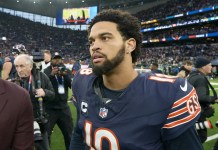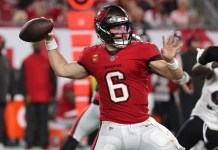We have now entered full NFL mock draft season. Draftniks all over are offering player evaluations and producing mock drafts — this isn’t a new phenomenon. In February of 1958, the Independent Press Telegraph (serving the Long Beach, California area), produced the first mock draft. Bob Kelly, the voice of the Rams and a long-time radio personality, wrote it after the draft, which was held in January of that year (as were most drafts until the 1980’s). “Then, in June, the Rams will stage a ‘mock draft,'” Kelley wrote. “They will pretend they are actually going into a regular draft meeting, and will rate — in order — the top 300 players in the country.” From that line in a local paper, the mock draft craze began. And boy did it boom.
Mock drafts are fun to read, and each NFL team will pay attention to some of them, more to collect data on the names being discussed. The collection of names in the top 100 allows teams to gain a slight — although not completely accurate – sense of the range where prospects on their draft board might get selected. It helps teams when they are reviewing their horizontal board. What most fans and draftniks don’t understand is each team’s draft board has essentially two boards in one.
***Top NFL Resources***
*Join thousands of other sports bettors and unlock access to picks, public betting spits data, & the VSiN live video broadcast by upgrading to VSiN Pro. Grab your first month for less than $10.*
- NFL Expert Picks
- NFL Betting Hub
- NFL 2024 Week-By-Week Schedule
- Parlay Calculator
- NFL Betting Splits
- NFL Betting Odds
The vertical board aligned by position is the easiest one to formulate. You ask one simple question (“Who is better?”) when players have the same grade, then stack the board accordingly. The horizontal board offers the biggest challenge with the fewest experts available to make the decision. For example: There are two players both graded a 6.2, which means both will be potential starters in the league by their second season. One plays cornerback, the other plays offensive guard. Who is better? Who will make the most impact? Some might say, take the player at the position of need, but what happens if both positions are needed? Who can make the right call? Some scouts haven’t seen all the players, so they can’t compare one to another. Only a few members of the organization have evaluated and compared, therefore, they must make the call. And this is the hardest call to make.
Since most mocks are built around team needs, the horizontal board is ignored. For example, the Carolina Panthers need a quarterback, so most mocks have them selecting Kenny Pickett or Malik Willis. The reasoning behind the selection is straight forward: Because Panthers head coach Matt Rhule is on the hot seat and needs a quarterback, Rhule must fix the position — and by selecting Pickett or Willis, this solves his problem. But does that actually solve the team’s QB problem?
Ask yourself this question: When has there ever been a rookie quarterback that saved a coach’s job? Did Justin Fields save Matt Nagy? Did Mitchell Trubisky save John Fox? No chance. In fact, if you examine the numbers of selecting quarterbacks in the first round, picking one early, won’t save your job — it will get you fired.
Since 2000, 65 quarterbacks have been selected in the first round of the NFL draft (an average of roughly 3.38 a year), and at least one quarterback’s name has been called by the Commissioner in every first round. In only two drafts over the last 22 seasons, just one quarterback was selected (2000, Chad Pennington; 2013, EJ Manuel).
Over the last 22 NFL drafts:
15 quarterbacks have been selected No. 1 overall.
30 QBs have gone in the top five.
40 QBs have been taken in the top 10.
18 have been selected in the second half of the first round (picks 16-32)
13 of the 65 QBs have started over 100 games.
18 have started more than 80 games (five full seasons).
17 have made at least two Pro Bowls.
5 have made All-Pro and 11 started one year or less.
Of the 65 selected — removing the yet-to-be-determined talent of first- and second-year players like Mac Jones, Trevor Lawrence, Zach Wilson, Justin Fields, Trey Lance, Tua Tagovailoa and Jordan Love — 15 QBs have qualified as a franchise starter. That designation means, a player capable of consistently winning games and raising the level of play of the offense.
- Ben Roethlisberger (No. 11 overall)
- Phillip Rivers (No. 4)
- Eli Manning (No. 1)
- Matt Ryan (No. 3)
- Aaron Rodgers (No. 24)
- Carson Palmer (No. 1)
- Cam Newton (No. 1)
- Andrew Luck (No. 1)
- Michael Vick (No. 1)
- Patrick Mahomes (No. 10)
- Josh Allen (No. 7)
- Deshaun Watson (No. 12)
- Lamar Jackson (No. 32)
- Justin Herbert (No. 6)
- Joe Burrow (No. 1)
Even though Joe Flacco took the Ravens to a Super Bowl win in 2013, he doesn’t fit the franchise label, nor does Jay Cutler or Ryan Tannehill.
Without listing the major flops and infuriating the fan bases of those teams one more time, it’s fair to conclude that when selecting a quarterback in the first round, there is a 25.86% chance (15 of 58) of finding a starter with talent to lead the team to a title. Yet teams continue to pick QBs in the first round, knowing that drilling for oil in West Texas has better odds.
It’s easy for the mock draft selector to give the team a quarterback because it fills the need, yet in reality it doesn’t. Selecting a quarterback is a high-risk, high-reward proposition. Most teams that make the mistake of selecting bad quarterbacks fall prey to what Panthers general manager Scott Fitterer said recently:
"This will be interesting because the tackles will be the best players on the board. But we do need a quarterback, and at some point you have to take a shot, especially in the top 10," Fitterer said, via the Panthers website. "You hate to force it, because when you force it, you could make a mistake.” Scott, in this draft if you select a quarterback in the top 10, you are forcing it.
One of the beautiful things about the draft is the history each one can teach us, if we’re willing to pay attention. Hall of Fame executive Ron Wolf was highly prepared for his first job as general manager. After spending 12 years working alongside of Raiders owner Al Davis, Wolf was ready to build a team when the newly-formed Tampa Bay Buccaneers hired him as their Vice President of Operations. Wolf was a well-seasoned scout, understood the NFL game and most of all, he knew the essence of team building. Preparing for his first draft, with the No. 1 pick overall, Wolf had every intention of selecting a quarterback for his new franchise to build around. Wolf, from his time as Davis’ main confidant, knew having a quarterback and dominating players on both the offensive and defensive lines was the foundation for success. And like Davis, Wolf valued size and speed at all position, believing the bigger faster team would always win.
The first problem — of many for Wolf in Tampa — was the 1976 NFL draft didn’t have a QB worthy of the No. 1 pick, or in Wolf’s evaluation, worthy of being a first-round player. If Wolf took a quarterback, he was ignoring the horizontal board and risking a mistake.
Richard Todd of Alabama was the consensus best quarterback in the class. Todd was a three-year starter at Alabama running the wishbone, and only threw 17 touchdown passes and 7 interceptions during those three seasons. Todd was a projection to play the position, as most quarterbacks were from that era. There was no evidence he would adapt to the pro game, and if he did, his talent as a passer along with his decision making would be questionable. Wolf knew Todd wasn’t the man to represent his first pick, and his final grade could never justify being the first pick overall. For Wolf, there was only one man worthy of that distinction: Lee Roy Selmon.
Wolf knew if he selected Todd, his positional need would look good on paper, and bad on the field. He understood the two boards perfectly, and wasn’t going to take a risk for a player he knew wasn’t as good, even though he played an important decision. And Wolf wasn’t in danger of losing his job, as he was just starting.
What we can conclude based on this study is that at least one QB will be selected in the first round, and it’s safe to assume at least two will be. What is also safe to assume, is in three years, those teams that selected a quarterback in 2022 will be looking again for a new one — only this time with a new coach and general manager making the pick.




